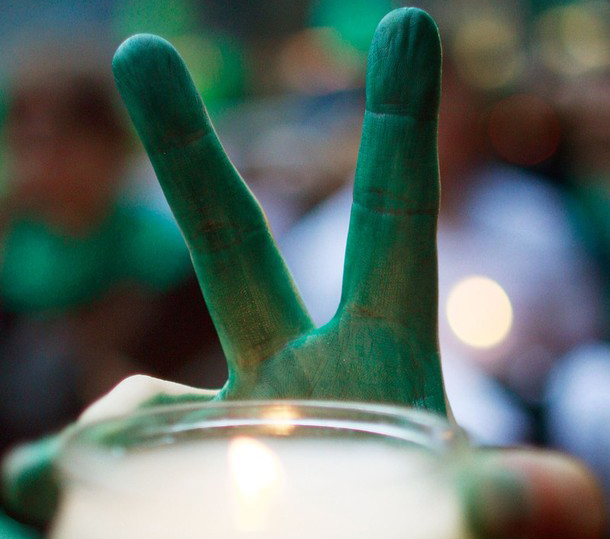
The deadline for Iran to accept a U.N.-brokered deal on its controversial nuclear program expired on December 31, proving yet again that the policy of modifying the behavior of the Islamic Republic is not working. While Washington frets over what the Obama Administration should do next, legitimate power is tilting away from the central government toward a confident Green Movement. More and more experts are concluding that it is no longer a question of whether the regime in Tehran will fall, but rather when.
The stranglehold on Iran’s economy wielded by elements of the Islamic Revolutionary Guard Corps (IRGC), and the state militia’s attack last month on mourners at the funeral of Grand Ayatollah Hossein Ali Montazeri, revealed to the nation as a whole, from city dwellers to villagers, and from the secular to the religious, that the Islamic Revolution has degenerated into an illegitimate cartel backed by merciless armed militias. In the meantime, disparate groups have coalesced into an inclusive Green Movement, representing the aspirations of a range of Iranians for social freedom, democracy and human rights.
The religious faction of the democratic movement comprises elements within the bureaucracy, university professors, teachers in religious seminaries and enlightened younger veterans of the IRGC who fought in the Iran-Iraq War and remain loyal to the legacy of the 1979 Islamic Revolution. The liberal and social democrats include women and youths, ethnic and religious minorities, workers in labor unions, and soldiers in the regular military.
The religious democrats consider the Green Movement a civil rights movement rather than a revolutionary one. They want to work within the system, reforming laws through deals with the existing clusters of power in the Islamic Republic. By contrast, liberal and social democrats view the system through the prism of universal and indivisible human rights, and insist that the current constitution and political structure obstruct fundamental civil rights. Trying to reform the current system, they believe, is like rearranging chairs on the Titanic, adding that if the Islamic Republic of Iran were flexible, reformists would not be incarcerated or outside the country.
The absence of charismatic leadership and clear organizational networks in the face of the regime’s robust security-intelligence apparatus has served the Movement’s current framework for rebellion. In view of the different goals within the opposition, the question now being asked is how the Green Movement can evolve from a resistance movement into an alternative political force capable of ruling Iran.
Advocates of the Green Movement recognize that delaying discussions to resolve differences and to work through what comes next poses the danger that the rebellion, even in triumph, will degenerate into a chaotic settling of scores. Given Iran’s history, such an outcome could result in another dictatorship. This is why key thought leaders are taking advantage of the prevailing spirit of fellowship within the Movement to hold meetings through Skype, Paltalk, and other modern telecommunication devices that get around regime repression. These long distance meetings, termed "solidarity forums," address political, legal, economic and social concerns as well as foreign policy priorities. Participants include those who have mentored the last two generations of Iranian political and social scientists, and who are now leading the way in drawing up a road map for a modern, pluralistic, forward-looking Iran that both meets the aspirations of its citizens and can interact with the international community.
The sources of the opposition’s growing power are multiple, from secret networks within the regime’s bureaucracy to brave warriors willing to take bullets in the streets. But there is a missing international piece. Green Movement advocates recognize that although the critical momentum for change rests with Iranians, the role of the international community remains pivotal as the country faces looming sanctions in response to the regime’s flagrant violations of nuclear commitments and human rights conventions.
These same advocates hope for consistent international support for the Iranian people’s struggle for democracy and human rights, while in the same breath demanding a halt to the production of nuclear fuel. Indeed, prominent Iranian personalities have called on the international community to investigate human rights abuses and release all detainees. Leading opposition figures have also come around to supporting visa and travel bans for officials, and targeted sanctions aimed at the financial interests of the IRGC.
While no one should underestimate the capacity of a desperate regime to do anything to survive, its days are numbered. The Green Movement’s rebellion can eventually morph into a national unity government. To help ensure that a future government is imminent, representative, and effective, thoughtful Iranians continue to meet to calibrate their current strategies and map out their future.
The West will soon be presented with a choice between an Iran represented by an intransigent and unstable military cartel, or a peaceful, confident Iran that is striving to free itself from an oppressive regime. It remains to be seen whether in 2010 the significant popular pressure inside Iran, and the prospect of sanctions from outside, can be aligned or whether they will work at cross purposes. For the international community, the choice is about which Iran it prefers to engage.
Ansari is the diplomatic editor of the London-based weekly Iranian newspaper Kayhan. Paris is a nonresident senior fellow with the Atlantic Council’s South Asia Center and adjunct fellow with the London-based Legatum Institute. This essay was previously published as "The Future of Iran" in the Wall Street Journal. Photo: Getty Images.
Image: IranGreenMovement.jpg
